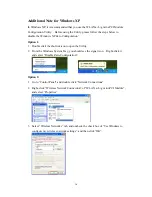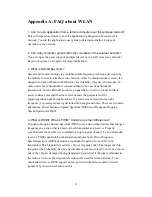
24
“Super A”, “Super G” or “Auto”. “Auto” allows the use of either 802.11a,
802.11g or 802.11b mode.
NOTE!
Ad-hoc mode is available only for 802.11b/g. It is not available
for 802.11a. This is a client product and do not have rador detection
function specified by FCC. The software will not let you to use ad-hoc
under 802.11a.
Ad Hoc Net Start:
Specifies a band to establish an Ad Hoc network if no
matching SSID is found. Options available are the following: 802.11b and
802.11g.
NOTE!
Ad-hoc mode is available only for 802.11b/g. It is not available
for 802.11a. This is a client product and do not have radar detection
function specified by FCC. The software will not let you to use ad-hoc
under 802.11a.
802.11b Range:
Options are
Normal Range
and
Extended Range
. This
function can let user to determine the transfer range in 802.11b mode.
Extended Range can prolong the transfer range with a lower data
transmitting rate.
Scan Mode:
Options are
Active Scan
,
Passive Scan
and
Auto
. In Active
Scan, the driver sends out the probe request frames from each channel and
collects the response frames from the responding. In Passive Scan, the
driver scan each requested channel, listening the beacons on each channel.
Transmit Power:
This setting allows you to change the output power of the
PC Card to increase or decrease the coverage area.
QoS:
Disables or enables the PC Card to cooperate in a network using QoS
(Quality of Service).
2.4 GHz Preamble:
Allows Ad-Hoc compatibility with other 2.4 GHz
devices. Two options are
Short and Long
and
Long only
. Use
Long Only
when configuring the client for an 802.11b RoamAbout AP wireless
network.











































